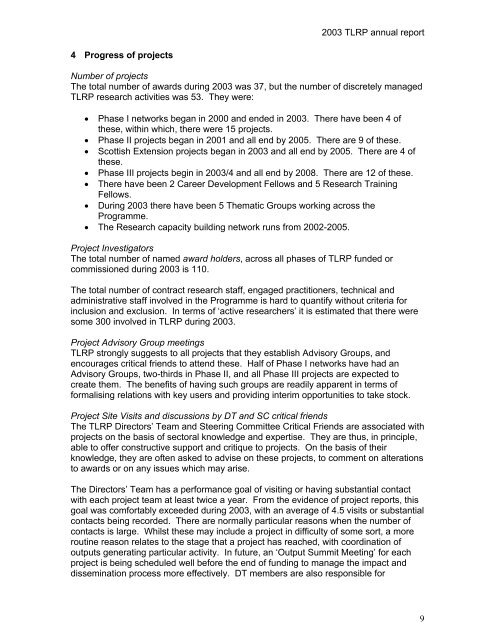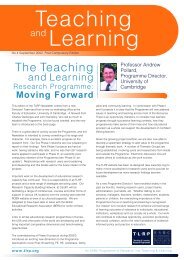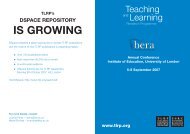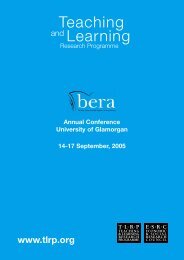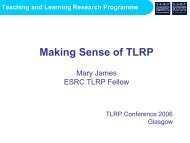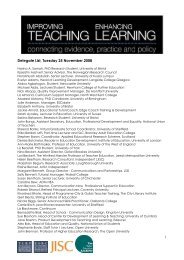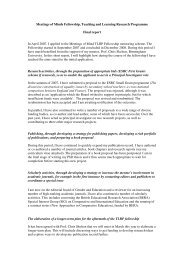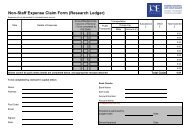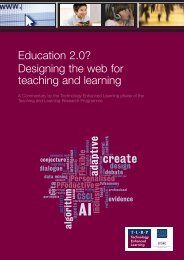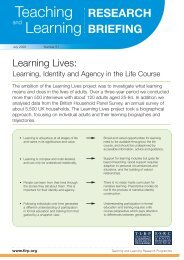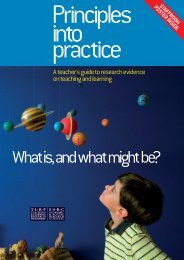Programme Director's Annual Report 2003 - Teaching and Learning ...
Programme Director's Annual Report 2003 - Teaching and Learning ...
Programme Director's Annual Report 2003 - Teaching and Learning ...
You also want an ePaper? Increase the reach of your titles
YUMPU automatically turns print PDFs into web optimized ePapers that Google loves.
<strong>2003</strong> TLRP annual report4 Progress of projectsNumber of projectsThe total number of awards during <strong>2003</strong> was 37, but the number of discretely managedTLRP research activities was 53. They were:• Phase I networks began in 2000 <strong>and</strong> ended in <strong>2003</strong>. There have been 4 ofthese, within which, there were 15 projects.• Phase II projects began in 2001 <strong>and</strong> all end by 2005. There are 9 of these.• Scottish Extension projects began in <strong>2003</strong> <strong>and</strong> all end by 2005. There are 4 ofthese.• Phase III projects begin in <strong>2003</strong>/4 <strong>and</strong> all end by 2008. There are 12 of these.• There have been 2 Career Development Fellows <strong>and</strong> 5 Research TrainingFellows.• During <strong>2003</strong> there have been 5 Thematic Groups working across the<strong>Programme</strong>.• The Research capacity building network runs from 2002-2005.Project InvestigatorsThe total number of named award holders, across all phases of TLRP funded orcommissioned during <strong>2003</strong> is 110.The total number of contract research staff, engaged practitioners, technical <strong>and</strong>administrative staff involved in the <strong>Programme</strong> is hard to quantify without criteria forinclusion <strong>and</strong> exclusion. In terms of ‘active researchers’ it is estimated that there weresome 300 involved in TLRP during <strong>2003</strong>.Project Advisory Group meetingsTLRP strongly suggests to all projects that they establish Advisory Groups, <strong>and</strong>encourages critical friends to attend these. Half of Phase I networks have had anAdvisory Groups, two-thirds in Phase II, <strong>and</strong> all Phase III projects are expected tocreate them. The benefits of having such groups are readily apparent in terms offormalising relations with key users <strong>and</strong> providing interim opportunities to take stock.Project Site Visits <strong>and</strong> discussions by DT <strong>and</strong> SC critical friendsThe TLRP Directors’ Team <strong>and</strong> Steering Committee Critical Friends are associated withprojects on the basis of sectoral knowledge <strong>and</strong> expertise. They are thus, in principle,able to offer constructive support <strong>and</strong> critique to projects. On the basis of theirknowledge, they are often asked to advise on these projects, to comment on alterationsto awards or on any issues which may arise.The Directors’ Team has a performance goal of visiting or having substantial contactwith each project team at least twice a year. From the evidence of project reports, thisgoal was comfortably exceeded during <strong>2003</strong>, with an average of 4.5 visits or substantialcontacts being recorded. There are normally particular reasons when the number ofcontacts is large. Whilst these may include a project in difficulty of some sort, a moreroutine reason relates to the stage that a project has reached, with coordination ofoutputs generating particular activity. In future, an ‘Output Summit Meeting’ for eachproject is being scheduled well before the end of funding to manage the impact <strong>and</strong>dissemination process more effectively. DT members are also responsible for9


